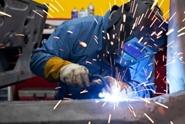Market Data

December 27, 2016
Manufacturers Are Optimistic About Future Activity
Written by Sandy Williams
Manufacturing surveys by the Federal Reserve Banks of Dallas and Richmond indicated that manufacturers are expecting positive business conditions in the first half of 2017. Activity is expected to be stronger in the Fifth District area than Texas but both regions see improvement conditions in the New Year.
Federal Reserve Bank of Dallas
Manufacturing activity in Texas increased for the sixth consecutive month in December. The production index of the Texas Manufacturing Outlook survey rose five points to 13.8 for the month.
Other components of the index were mostly positive and indicative of expansion of activity. New orders climbed out of negative territory, gaining nine points to post a reading of 7.3. The growth rate of orders however, was still negative at -3.4.
Capacity utilization was at its highest reading in more than two years and shipments climbed seven points to 4.7 in December.
Survey participants were optimistic about current business conditions with the index moving upwards to 15.5. The outlook index increased six points for a reading of 17.4.
Employment declined slightly but workweek length increased modestly. The employment index dropped to -2.9 after three months of positive postings.
Input prices increased sharply, with the raw material prices index jumping 10 points to 28.1. The index for finished good prices climbed 6.7 points to 14.7, its highest level since 2012. The wages and benefit index rose to 18.7 in December.
Survey participants were especially optimistic about business conditions for the coming months. The future general business activity index rose 8 points to 39.7. The future company outlook index rose by double-digits to 46.8 and its highest reading in 12 years.
Fifth District (Federal Reserve Bank of Richmond)
Manufacturing activity increased in the Fifth District in December, according to the Federal Reserve Bank of Richmond. The District includes the District of Columbia, Maryland, North Carolina, South Carolina, Virginia and most of West Virginia. The composite index for manufacturing rose to a reading of 8 from a reading of 4 in November.
Shipments and new order indexes posted advanced 11 and 5 points to a reading of 12 for both indexes. Capacity utilization also grew at a faster rate. Inventories of finished goods fell seven points to a reading of 11. Raw material inventories added two points to the index reading.
Vendor lead times were longer and the backlog index leapt 20 points to a reading of 8. Employment growth softened in December and was generally flat at a reading of -1. Workweek length, however, increased.
Manufacturers in the survey were optimistic about future business conditions during the next six months. Shipments and orders are expected to grow vigorously along with higher capacity utilization. Vendor lead times are expected to lengthen slightly and backlogs to increase.
Prices for raw materials and finished goods are expected to increase at a faster rate during the next six months. According to survey results, firms expect input prices will rise more quickly, at an annualized 1.30 percent pace, while finished goods prices rise at an annualized 1.46 percent rate.
More firms are expecting to hire employees. The outlook index for employment rose seven points to a reading of 22. Average wages are expected to increase along with length of the average workweek.







